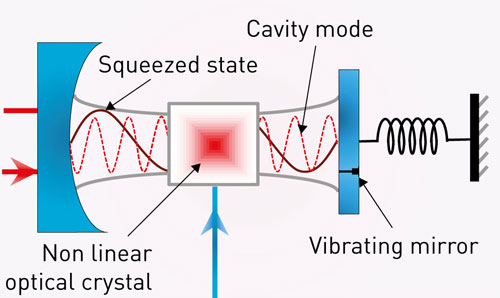Optical Cavities: Harnessing Light at the Nanoscale
What are Optical Cavities?
Optical cavities, also known as optical resonators, are structures that confine light within a small volume by utilizing highly reflective surfaces. These cavities allow light to circulate or bounce back and forth multiple times, leading to a buildup of optical energy. Optical cavities are fundamental components in various applications, including lasers, optical filters, and quantum photonics.

Key Concepts in Optical Cavities
Several key concepts are essential to understanding the behavior and properties of optical cavities:
Resonance
Optical cavities exhibit resonance, meaning that they selectively enhance light at specific wavelengths, known as resonant wavelengths. These wavelengths are determined by the cavity's geometry and the properties of the reflective surfaces. When light at a resonant wavelength enters the cavity, it constructively interferes with itself, leading to a buildup of optical energy.
Quality Factor (Q-factor)
The quality factor, or Q-factor, is a measure of an optical cavity's ability to confine light. It quantifies the ratio of the energy stored in the cavity to the energy lost per oscillation cycle. Higher Q-factors indicate lower optical losses and longer photon lifetimes within the cavity. High-Q cavities are essential for applications requiring strong light-matter interactions, such as cavity quantum electrodynamics (CQED).
Mode Volume
The mode volume is the effective volume occupied by the resonant optical mode within the cavity. Smaller mode volumes lead to stronger light-matter interactions and higher optical energy densities. Nanoscale optical cavities, such as photonic crystal cavities and plasmonic nanocavities, can achieve extremely small mode volumes, enabling the exploration of novel optical phenomena and applications.
Types of Optical Cavities
Optical cavities come in various forms, each with unique characteristics and applications:
Fabry-Pérot Cavities
Fabry-Pérot cavities, also known as Fabry-Pérot etalons, consist of two highly reflective mirrors separated by a distance. Light enters the cavity through one of the mirrors and bounces back and forth multiple times, creating standing waves at resonant wavelengths. Fabry-Pérot cavities are widely used in lasers, optical filters, and interferometers.
Whispering Gallery Mode Cavities
Whispering gallery mode (WGM) cavities are formed by dielectric structures with a circular or spherical geometry, such as microspheres or microtoroids. Light is confined within the cavity by total internal reflection at the dielectric-air interface, leading to high Q-factors and small mode volumes. WGM cavities are used in sensing, nonlinear optics, and cavity optomechanics.
Photonic Crystal Cavities
Photonic crystal cavities are created by introducing defects in periodic dielectric structures known as photonic crystals. The periodic structure creates a photonic bandgap, preventing light propagation in certain wavelength ranges. By carefully designing defects, light can be confined within the cavity at specific wavelengths. Photonic crystal cavities offer high Q-factors and extremely small mode volumes, making them promising for quantum photonics and integrated optics.
Plasmonic Nanocavities
Plasmonic nanocavities exploit the unique properties of surface plasmons, which are collective oscillations of electrons at metal-dielectric interfaces. By structuring metals at the nanoscale, light can be confined to volumes much smaller than the diffraction limit. Plasmonic nanocavities enable strong light-matter interactions and find applications in sensing, spectroscopy, and nanolasing.
Applications of Optical Cavities
Optical cavities find numerous applications in various fields, including:
Lasers
Optical cavities are essential components of lasers, providing the necessary feedback and amplification for light emission. The cavity's resonance properties determine the laser's wavelength, linewidth, and output power. Different types of cavities, such as Fabry-Pérot cavities and distributed feedback (DFB) cavities, are used in lasers for diverse applications, from telecommunications to material processing.
Sensing and Metrology
Optical cavities are highly sensitive to changes in their environment, making them ideal for sensing applications. Cavity-enhanced sensing techniques, such as cavity ring-down spectroscopy (CRDS) and whispering gallery mode sensing, can detect minute changes in the cavity's optical properties caused by the presence of analytes or physical perturbations. Optical cavities are also used in high-precision metrology, such as gravitational wave detection and atomic clocks.
Quantum Information Processing
Optical cavities play a crucial role in quantum information processing, enabling the manipulation and storage of quantum states of light. Cavity quantum electrodynamics (CQED) explores the interaction between atoms or quantum emitters and cavity modes, forming the basis for quantum networks and quantum memories. Optical cavities are also used in the generation and processing of non-classical states of light, such as single photons and entangled photon pairs.
Challenges and Future Perspectives
Despite the significant progress in optical cavity technology, several challenges remain. One of the main challenges is the fabrication of high-quality optical cavities with precise control over their geometry and material properties. The development of novel materials and fabrication techniques, such as 3D nanoprinting and atomic layer deposition, may enable the realization of advanced optical cavities with unprecedented performance.
Another challenge lies in the integration of optical cavities with other photonic and electronic components on a single chip. The development of integrated photonic circuits incorporating optical cavities, waveguides, and active devices is crucial for scalable and practical applications in quantum information processing, sensing, and communications.
Future research in optical cavities will focus on pushing the limits of light confinement, exploring novel cavity designs, and harnessing the unique properties of emerging materials, such as 2D materials and metamaterials. The integration of optical cavities with other quantum systems, such as mechanical resonators and superconducting circuits, will open up new avenues for hybrid quantum technologies. Additionally, the application of machine learning and computational design techniques will accelerate the discovery and optimization of optical cavities for specific applications.
Further Reading
Chemistry – A European Journal , Optical Cavity Design and Functionality for Molecular Strong Coupling
American Journal of Physics, A basic introduction to ultrastable optical cavities for laser stabilization
Laser & Photonics Reviews, Optical Resonator Enhanced Photovoltaics and Photocatalysis: Fundamental and Recent Progress
